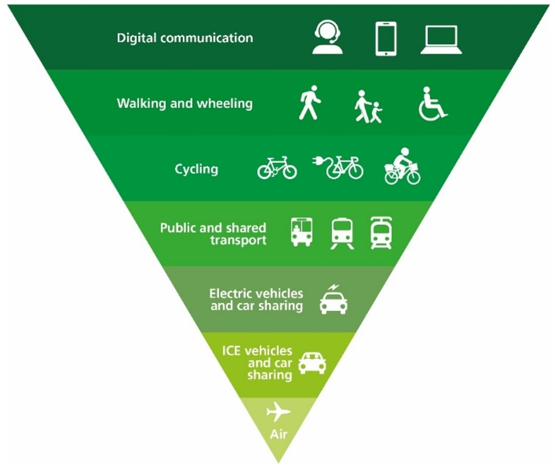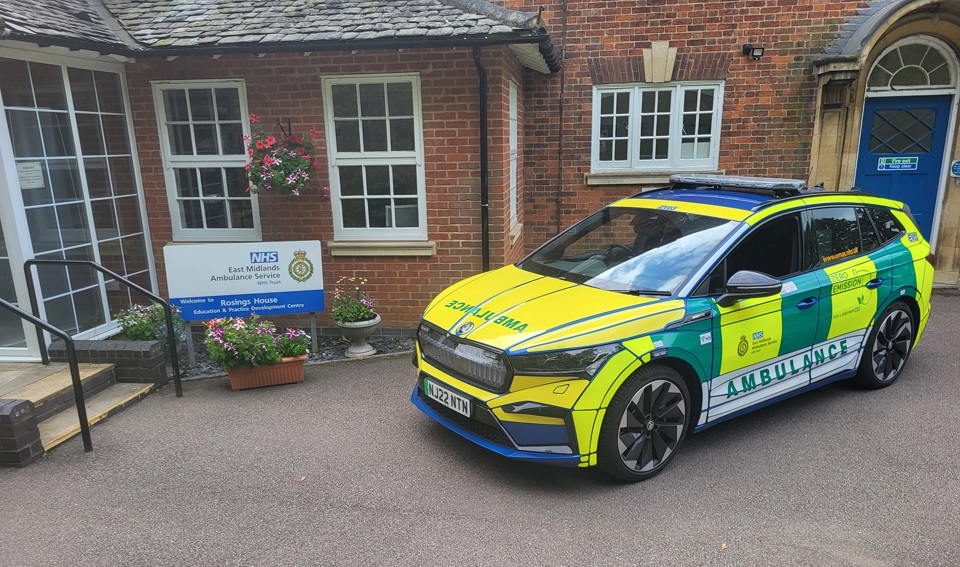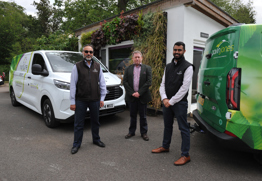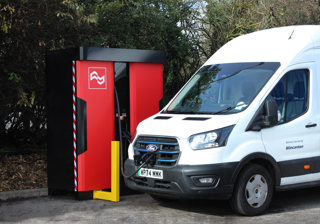Decarbonising the transport of an organisation as large and diverse as NHS England is a huge task, but the benefits are equally as enormous.
Under the organisation’s NHS England Net Zero Travel and Transport Strategy, there will be an annual carbon emission reduction of 70%, based on the way electricity is currently generated, according to National Grid figures. This will fall as the grid decarbonises further.
“If we also look at the health and societal benefits, and annual direct NHS savings, we can see they are not only significant in terms of their make-up and their contribution to the NHS, but to society more widely,” says Andrew Bradley, net zero travel and transport lead at NHS England.
He adds it will require a one-off direct investment of around £100 million to fully electrify the NHS fleet, but this would yield annual savings of up to £59m in fuel, servicing and maintenance according to the Treasury’s Green Book prices.
“We recoup that cost pretty quickly,” he adds. “Then there’s the monetised societal benefits, such as benefits to population health, fuel, road accidents, etc., which is calculated to be £235m.”
The strategy outlines how the organisation can reach its NHS Net Zero Carbon Footprint Target of having its full fleet decarbonised by 2040, while all business travel will also be zero emission by that date.
It also has an additional target for 2045, by which date staff commuting and patient and visitor travel will also be zero emission.
Decarbonising the NHS England fleet
The NHS owns and leases more than 20,000 vehicles – a fleet second only in size to the Royal Mail nationally – for use in a range of care settings.
The net zero strategy states all new vehicles – excluding ambulances – it owns or leases will be zero emission by 2027.
“We are currently at 11%,” says Bradley. “We have quite a lot of disparity from place to place nationally. There is more work to be done in some parts of the country than in others.”
It has made strong early progress: seven ambulance trusts are currently trialling 21 zero-emission emergency vehicles, six of which are dedicated mental health response vehicles, cutting emergency response times and reducing demand on traditional double-crewed ambulances.
Other examples include 12 new electric 19-tonne trucks being trialled across the NHS, while London Ambulance Service NHS Trust has procured 42 fully-electric fast response vehicles.
To help NHS Trusts to adopt EVs, NHS England has produced a guide to help Trusts with the transition, including a focus on charging infrastructure.
“This will be available to all NHS colleagues and is really important because it addresses some of the frequently-asked questions in terms of what charging should be provided, who should it be for, what speed the charging should be,for example," says Murray.
“We are absolutely not advocating that NHS Trusts should be installing chargers for private individuals to charge their cars on NHS sites. The priority should be charging the fleet.”
Some Trusts are also looking for more innovative solutions to reduce emissions.
Several based in cities are using e-cargo bikes to transport goods between sites. For example, Oxford University Hospital Trust found the use of an e-cargo bike to deliver chemotherapy treatments increased reliability and efficiency, while mitigating the effect of rush-hour traffic on and around the hospital site.
Guys and St Thomas’ Foundation Trust has transformed the way it transports vital medical supplies.
A twice-daily riverboat service brings operating theatre equipment along the River Thames, with the last-mile delivery to the hospital sites from the boat terminal done by e-cargo bike.
By taking three diesel delivery trucks off the road, the initiative saves 37 tonnes of CO2 emissions each year.
Some Trusts are also looking to the skies. For the first time ever, drones have been used to deliver vital chemotherapy to the Isle of Wight, reducing a four-hour journey time by road and sea to a 30-minute flight.
This autumn, Northumbria Healthcare NHS Foundation Trust will also begin to use electric, autonomous drones to deliver medical supplies to hospitals, GPs and care homes.
This service is being operated by Zipline, and the fixed-wing aircraft are able to travel up to 130 miles in almost any weather condition, and release packages with parachutes that float down to a hospital’s outdoor area.
During the six-month trial, the drones will operate Monday to Friday between 8am and 6pm, with an average 45 deliveries taking place each day.
The travel and transport strategy also stipulates that, from 2026, all vehicles offered through the NHS vehicle salary sacrifice schemes will be fully-electric.
“We’re quite a long way from that at the moment,” says Bradley. “There is quite a lot of disparity nationally, but perhaps that reflects where the best charging infrastructure currently is, with London leading the way on that.”
Business travel
NHS England has also adopted a sustainable travel hierarchy with digital communication at the top and air travel at the bottom.

“Who uses air travel for the NHS you may ask,” says Bradley. “Well, actually, there is air travel within the NHS, often associated with the recruitment of new staff from overseas.
“There’s also a tiny bit of domestic travel by air as well, and we really want to cut down on that wherever possible.
“But that’s the minority and I think we’ve got a lot to go on, frankly, with the walking, wheeling, cycling, public and shared transport, without worrying too much about air travel.”
Guy’s and St Thomas’ green travel plan uses the same travel hierarchy and has fleshed out the with plan with details specific to its operation:
- Travel avoidance: ensure all staff have viable remote options in line with the NHS People Plan targets
- Walking: the trust will promote walking as the default mode of travel for all journeys within 1km (15-20 minute walk). Also ensure all its acute hospital sites exceed all minimum standards for pedestrian comfort and safety by 2025.
- Cycling: expand provision of active travel facilities, including providing e-bikes for community-based staff at a minimum of four locations to carry out their home visits. Also ensure at least 10% of all journeys between trust sites are cycled by 2027.
- Public transport: ensure at least 70% of all journeys between trust sites are made by public transport by 2027, monitored through annual staff travel surveys.
- Motor vehicles: achieve a year-on-year reduction in staff private car use by 2024.
- Flights: ensure that rail travel is the default mode for all domestic mainland business journeys that cannot be done virtually by 2024.
University Hospitals of Leicester NHS Trust has funded its own Hopper bus service, which travels between its three hospitals, located in the east, in the centre and on the west of the city.
“It’s free for NHS staff while the public pays a small fee to offset the cost of running it,” says Bradley.
“Leicester has been pretty clear that it has laid on that bus service for staff to use to get from site to site, and it expects staff to use it, rather than using their own vehicles and billing the trust for the pleasure of doing that.
“It’s cheaper to run this service than to pay the taxi fees and grey fleet mileage that the service has replaced.”
Sheffield Children’s Hospital is committed to supporting staff to cycle for business travel where appropriate, and has increased its cycling reimbursement rate from 20p per mile to 40ppm.
“That has tripled the number of cycling miles claimed for under their business travel reimbursement scheme over the past six months,” adds Bradley.
Staff commuting
The introduction of the travel hierarchy and provision of alternatives to staff using their own car for business journeys – the grey fleet – also means employees will be able to use other modes of transport to get to work.
This will relieve pressure on site car parks, as well as help towards its 2045 NHS Net Zero Carbon Footprint Plus target, which includes eliminating carbon emissions from staff commuting as well as patient and visitor travel.
“We’ve been working intensively with the trusts in terms of staff commuting,” says Bradley.
NHS England has set up one of the UK’s largest modal shift networks – Step Up a Gear – with more than 50 individual trusts involved. This is focused on developing, refining and sharing best practice interventions.
One of the trusts involved – Hull and East Yorkshire Hospitals NHS Trust - achieved a 13.5% reduction in staff commuting on their own in cars between spring 2022 and spring 2023.
“That is massive, and I think most trusts would give their right arm to see a 13.5% swing,” says Bradley.
“There were a lot of reasons for that, principally investment in public transport and in cycling facilities and support for cyclist.
“There were also some changes to their parking permit system, not necessarily a reduction in the number of parking permits, but in making the parking permit system more intelligent so that people could perhaps cycle or take the bus some of the time, but still drive some other times and not be penalised for doing that.”
The trust saw a 7.2% increase in commuting by bus, and a 2% increase in staff travelling to work by bicycle.






















Login to comment
Comments
No comments have been made yet.